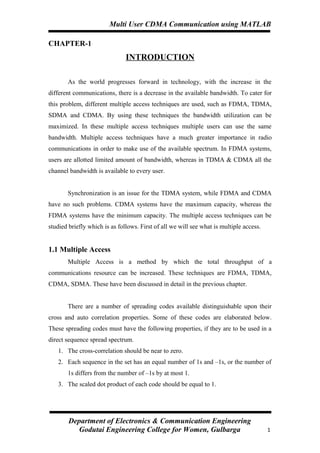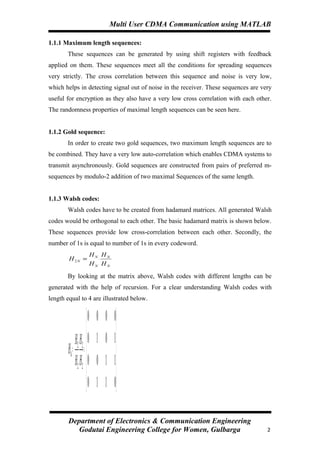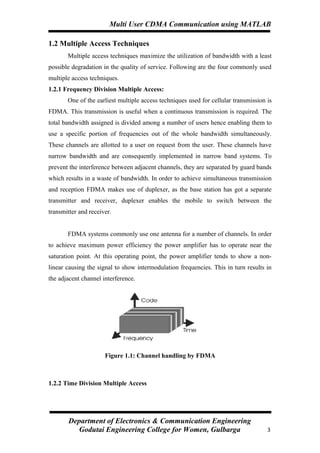The document discusses multi-user CDMA communication using MATLAB. It introduces multiple access techniques such as FDMA, TDMA, SDMA and CDMA that allow multiple users to utilize the same bandwidth. CDMA uses direct sequence spread spectrum that spreads the message signal over a wider bandwidth using a PN code. The document discusses various spreading codes used in CDMA like maximal length sequences, Gold codes and Walsh codes. It then describes multiple access techniques in detail, including FDMA, TDMA, SDMA and CDMA. The block diagram of a DS-SS system is also presented.






![Multi User CDMA Communication using MATLAB
CHAPTER-2
LITEATURE SURVEY
PSEUDONOISE (PN) code synchronization is the necessary first step in the
receiver of direct-sequence code-division multiple-access (DS-CDMA) systems, since
data demodulation becomes possible only after the code synchronization is
performed. Code synchronization is usually achieved in two steps: 1) acquisition for
coarse code alignment and 2) tracking for fine alignment [1]. Acquisition methods can
be broadly classified as serial search methods [2]–[9] and parallel search methods [3],
[10]–[14], which have been extensively treated in the literature. In a serial search
scheme, each possible code phase of a given roster position in the uncertainty region
is tested one at a time, while in a parallel search strategy, many, if not all, of the
possible code phases are tested simultaneously.
The focus of this paper is on serial search acquisition. In a practical PN
sequence acquisition system, usually there exist multiple in-phase states (cells) in the
uncertainty region, since the search step size is usually lower than the chip duration
and the dispersive fading-induced delay spread is higher than the chip duration of the
PN sequence. However, despite the existence of multiple cells in almost any practical
PN code acquisition system, the majority of published results concerning the mean
acquisition time (MAT) have been derived from the assumption that there is one and
only one cell in the uncertainty region [1]–[7], [9]–[14]. The performance of the
acquisition system with multiple cells has received comparatively little attention in
the literature.
Hence, our goal in this paper is to quantify the performance of serial search
acquisition systems under the hypothesis that there are multiple cells in the
uncertainty region of the PN sequence. Specifically, we assume that the search step
size is 2, where is the chip duration. Hence, each resolvable path of the received
signal contributes two cells. The acquisition process of the serial search mode under
the multiple –cell hypothesis can be described using the so-called equivalent circular
state diagram [2], [4], [17], which will be detailed in the context of Fig. 2.
Department of Electronics & Communication Engineering
Godutai Engineering College for Women, Gulbarga 7](https://image.slidesharecdn.com/3-170422030236/85/3-final-report-7-320.jpg)
![Multi User CDMA Communication using MATLAB
By extending the result of [17] in this paper, a generalized equation is derived
for computing the MAT of a serial search system under the multiple -cell hypothesis.
In our analysis, two detection schemes are considered. The first is the conventional
cell-by-cell detection [5], in which each cell is tested independently; the second is the
novel joint two-cell detection [15], [16], in which two adjacent cells are tested jointly.
The MAT performance of the serial search scheme using both of the above detection
approaches is investigated over a frequency- selective multipath Rayleigh fading
medium. Note that the analysis presented is applicable to the mobile-to-base station
link of a DS-CDMA system utilizing binary phase-shift keying (BPSK) spreading.
The remainder of this paper is organized as follows. In Section II, we describe
the search and detection modes proposed. Then, the asymptotic MAT is derived in
Section III. The system and channel models are given in Sections IV and V. In
Section VI, the test statistics of the decision variables are analyzed, while in Section
VII we derive the overall miss probability and the false alarm probability, which are
defined in Section III. Numerical results are given in Section VIII. Our concluding
remarks are given in Section IX. Let us now consider the search and detection modes
concerned in this paper.
Department of Electronics & Communication Engineering
Godutai Engineering College for Women, Gulbarga 8](https://image.slidesharecdn.com/3-170422030236/85/3-final-report-8-320.jpg)




![1u
1u
Output coded bits
21,uu
Input data
Multi User CDMA Communication using MATLAB
Convolution Block codes:
Three major integers used in these codes are n, k, K. n is the number of
encoded bits, k is the number of input information bits and K is the constraint length
that describes the number of stages on which the output would be dependant. k/n
defines the information per coded bit. The codeword that is produced as a result of
this encoding maybe denoted as U = (U1, U2 . . . Un)
At the receiver end, the decoder receives a sequence Z = (Z1, Z2…Zn). This
happens due to the non-ideal behavior of the transmission channel, i.e. the noise
present in the channel corrupts the incoming signal. The task of the detector would be
to rectify the data by extracting the sequence U from the corrupted sequence Z. This
would be possible if the receiver has a priori knowledge of how the information was
encoded at the transmitter's end. [6]
Connection representation:
The connection representation of convolution encoders is shown in the figure
below. This can be represented as
1111 =g
1012 =g
Figure 5.2: Connection Representation of Convolution Coding
Polynomial Representation:
This representation is done with a point of view that that convolution coder
can be treated as a set of cyclic code shift registers. Convolution encoder connections
can also be represented by ‘n’ generator polynomials.
Department of Electronics & Communication Engineering
Godutai Engineering College for Women, Gulbarga 13](https://image.slidesharecdn.com/3-170422030236/85/3-final-report-13-320.jpg)










![Multi User CDMA Communication using MATLAB
REFERENCES
[1] Theodore.S.Rappaport, Wireless communications Principles and practice (2nd
edition), Prentice Hall PTR, INC.USA 2003.
[2] Shetty, Kiran Kumar “A NOVEL ALGORITHM FOR UPLINK
INTERFERENCE SUPPRESSION USING SMART ANTENNAS IN
MOBILE COMMUNICATIONS” Electronic Thesis & Dissertations, vol. 14,
pp 35-92, Feb. 2004.
[3] Spread Spectrum Communications and CDMA, UCL Communications and
Remote Sensing Lab, Bruxelles, Germany.
[4] Kamil Sh. Zigangirov, John B. Anderson Theory of code division multiple
access, John Wiley & SONS, INC., 2004.
[5] Samuel.C.Yang, CDMA RF system Engineering, Artech House MA, USA,
1998.
[6] Bernard Sklar, Digital Communications Fundamentals and applications,
Prentice Hall INC. USA, Upper Saddle River, New Jersey, USA,1998.
[7] Complextoreal, January 20th, 2008, CDMA
http://www.complextoreal.com
Accessed at April 4th, 2008
Department of Electronics & Communication Engineering
Godutai Engineering College for Women, Gulbarga 24](https://image.slidesharecdn.com/3-170422030236/85/3-final-report-24-320.jpg)